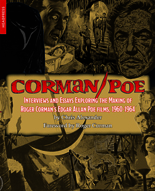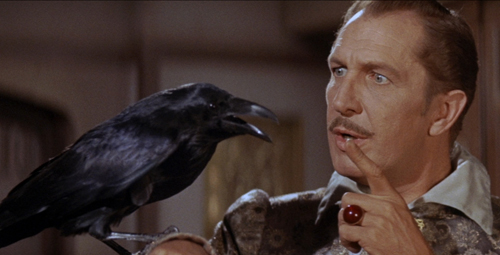
 While Roger Corman’s reputation of frugality holds merit, it’s all too often considered synonymous with “talentless,” which simply isn’t true. Whenever someone has questioned Corman’s competence as director, his cycle of Edgar Allan Poe films for AIP has served as my go-to defense. Genuine art and entertainment reside in that octet.
While Roger Corman’s reputation of frugality holds merit, it’s all too often considered synonymous with “talentless,” which simply isn’t true. Whenever someone has questioned Corman’s competence as director, his cycle of Edgar Allan Poe films for AIP has served as my go-to defense. Genuine art and entertainment reside in that octet.
Chris Alexander needs no such swaying; he’s been all-in since childhood. Now, the Delirium magazine editor and filmmaker himself (Necropolis: Legion) devotes an entire book to the subject in — take a breath — Corman/Poe: Interviews and Essays Exploring the Making of Roger Corman’s Edgar Allan Poe Films, 1960-1964. Annnnnd exhale.
For anyone already in Alexander’s camp, myself included, the Headpress release is a must-own.
Whether Tales of Terror or Tomb of Ligeia, each movie earns its own chapter. Without fail, each chapter is split into three sections: a synopsis, an interview with Corman, then Alexander’s analysis — let’s just call it a review so you don’t discount the work as pud-pulling academia. Alexander may be prone to hyperbole on occasion, but the mofo can write.
Of these sections, the interviews are the book’s raison d’être. Corman graciously gives credit where it’s due, primarily to production designer Daniel Haller, cinematographer Floyd Crosby and screenwriter Richard Matheson. (Oddly, future director Nicolas Roeg’s exquisite photography on The Masque of the Red Death goes undiscussed.) Without bad-mouthing Mark Damon, Corman also dispels the actor’s claim of directing The Pit and the Pendulum.
In the same gentlemanly manner, Corman reveals how he got Vincent Price to emote on the proper wavelength on the first film, The Fall of the House of Usher; how Ray Milland measured against Price, who was unavailable for The Premature Burial; how Peter Lorre’s style threw off Price and Boris Karloff on The Raven; how he worked around Karloff’s health issues; and what he thinks of AIP turning an H.P. Lovecraft adaptation into a Poe pic with a mere slap-on quote and title switcheroo for The Haunted Palace.
Because the interviews are presented Q&A-style, the reader can hear Corman’s every word in their head — even when he talks about the act of orgasming.
For the cycle’s last couple of entries in the cycle, the credit pages contain some inaccuracies — more likely due to layout. Visually, though, Corman/Poe is generously illustrated throughout. Of particular value is a full-color appendix of posters (Poe-sters?) from all around the globe, plus novelizations and comic books. —Rod Lott

